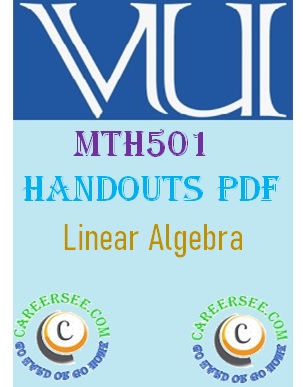Table of Contents
MTH501: Linear Algebra
Algebra is named in honor of Mohammed Ibn-e- Musa al-Khowârizmî. About 825, he wrote a book entitled Hisab al-jabr ul Muqabala, (“the science of reduction and cancellation”). His book, Al-Jaber, introduces mathematical rules. MTH501 Handouts pdf
MTH501 Handouts pdf
Course Category: Mathematics MTH501 Handouts pdf
Course Outline
Systems of Linear Equations, Row Reduction and Echelon Forms, Vector Equations, The Matrix Equation, Solution Sets of Linear Systems, Linear Independence, Linear Transformations, The Matrix of a Linear Transformation, Matrix Algebra, Iterative Solutions of Linear Systems, Determinants, Cramer’s Rule and Linear Transformations, Vector Spaces and Subspaces, Null Spaces, Column Spaces, and Linear Transformations, Linearly Independent Sets, Bases, Coordinate System, Dimension of a Vector Space, Rank, MTH501 Handouts pdf download
Change of Basis, Applications to Difference Equations, Eigenvalues and Eigenvectors, The Characteristic Equation, Diagonalization, Eigenvectors and Linear Transformations, Complex Eigenvalues, Discrete Dynamical Systems, Applications to Differential Equations, Iterative Estimates for Eigenvalues, Inner Product, Orthogonal and Orthonormal set, Orthogonal Decomposition, Orthogonal basis, Gram-Schmidt Process, Orthonormal basis, Least Square Solution, Inner Product Space, Application of inner product spaces. MTH501 Handouts pdf
Join VU assignment solution groups and also share with friends. We send solution files, VU handouts, VU past papers, and links to you in these WhatsApp groups. To join WhatsApp groups click the below links.
ALSO, SEE:
Jazz Internet Packages | Daily, Weekly, and Monthly and 3-Day Jazz
Zong free internet code 2022 | Get Free internet 3G/4G
TELENOR FREE INTERNET PACKAGES
JOIN VU STUDY GROUPS

MTH501 HANDOUTS
MTH501: Linear Algebra
Algebra
Algebra is a branch of mathematics that uses mathematical statements to describe the relationships between things that change over time. These changes include things like the relationship between the supply of an item and its value. When we use a mathematical statement to describe a relationship, we often use letters to represent a different value, as it is not a fixed value. These letters and symbols are called variables. Algebra is part of statistics where unknown values are obtained with the help of the relationship between the unknown and the unknown. In algebra, the letters are sometimes used instead of numbers.
What is Linear Algebra?
One of the most important problems in math is solving line math systems. It turns out that such problems often arise in the application of mathematics to the natural sciences, social sciences, and engineering. Put simply, the world is not clear, but the problems we can solve are those that are linear.
What this often means is that re-broadcasting them as line systems can solve indirect problems. Extensive study of line systems leads to a rich, formal framework for analyzing geometry and solutions for 2×2 and 3×3 line mathematical systems learned in previous classes.
That is exactly what the name implies. Simply put, the algebra of line mathematical systems. While you may be solving a program, say, five-line calculations consisting of five unknowns, it may not take the amount of time it takes. With line algebra, we create strategies for solving line math and unknown or showing where there is no solution.
We can even describe situations in which an infinite number of solutions exist, and describe them geometrically. Line algebra is a study of linear mathematical sets and their transformative features. Line algebra, sometimes hidden as matrix theory, considers sets and functions, which maintain line formation. By doing this it covers the widest part of the math!
Applications of Linear algebra
Line algebra makes it possible to work with large data sets. It has many applications in many different fields, such as
• Computer Graphics,
• Electricity,
• Chemistry,
• Biology,
• Different statistics,
• Economics,
• Business,
• Psychology,
• Engineering,
• Analytic Geometry,
• Chaos Theory,
• Cryptography,
• Fractal Geometry,
• Game theory,
• Graphic theory,
• Linear Programming,
• Job Research
It is very important that line algebra theory is first understood, concepts cleared and calculation work started. Some of you may want to use a computer and skip the theory and evidence, but if you do not understand the theory, it can be very difficult to inform and interpret computer results.
Objects of study in linear algebra
Linear algebra is worth learning at least because of its ubiquitous presence in math and its application. The widest range of applications is the concept of vector spaces and their modifications. These are the central objects of study in linear algebra:
1. Homogeneous systems of line mathematical systems create paradigm examples of vector spaces. Of course, they do not give examples only.
2. Physical vectors, such as force, as the language suggests, also provide paradigmatic examples.
3. Binary code is another example of a vector space, a point of view that is used in computer science.
4. Solutions for specific mathematical systems also create vector spaces.
5. Statistics make extensive use of line algebra.
6. Processing signals using line algebra.
7. Vector spaces also appear in numerical theory in a number of areas, including research for field extensions.
8. Line algebra is a component and promotes invisible algebra. Vector spaces form the basis on which an important algebraic view of the module is derived.


